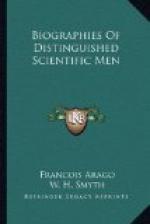I shall not quit this first part of the labours of Fourier without adding, that he has not contented himself with demonstrating with so much felicity the remarkable law which connects the comparative intensities of the calorific rays, emanating under all angles from heated bodies; he has sought, moreover, the physical cause of this law, and he has found it in a circumstance which his predecessors had entirely neglected. Let us suppose, says he, that bodies emit heat not only from the molecules of their surfaces, but also from the particles in the interior. Let us suppose, moreover, that the heat of these latter particles cannot arrive at the surface by traversing a certain thickness of matter without undergoing some degree of absorption. Fourier has reduced these two hypotheses to calculation, and he has hence deduced mathematically the experimental law of the sines. After having resisted so radical a test, the two hypotheses were found to be completely verified, they have become laws of nature; they point out latent properties of caloric which could only be discerned by the eye of the intellect.
In the second question treated by Fourier, heat presents itself under a new form. There is more difficulty in following its movements; but the conclusions deducible from the theory are also more general and more important.
Heat excited, concentrated into a certain point of a solid body, communicates itself by way of conduction, first to the particles nearest the heated point, then gradually to all the regions of the body. Whence the problem of which the following is the enunciation.
By what routes, and with what velocities, is the propagation of heat effected in bodies of different forms and different natures subjected to certain initial conditions?
Fundamentally, the Academy of Sciences had already proposed this problem as the subject of a prize as early as the year 1736. Then the terms heat and caloric were not in use; it demanded the study of nature, and the propagation OF FIRE! The word fire, thrown thus into the programme without any other explanation, gave rise to a mistake of the most singular kind. The majority of philosophers imagined that the question was to explain in what way burning communicates itself, and increases in a mass of combustible matter. Fifteen competitors presented themselves; three were crowned.
This competition was productive of very meagre results. However, a singular combination of circumstances and of proper names will render the recollection of it lasting.
Has not the public a right to be surprised upon reading this Academic declaration: “the question affords no handle to geometry!” In matter of inventions, to attempt to dive into the future, is to prepare for one’s self striking mistakes. One of the competitors, the great Euler, took these words in their literal sense; the reveries with which his memoir abounds, are not compensated in this instance




